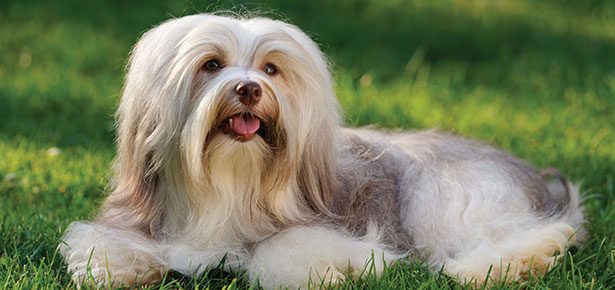

The Weimaraner
The gray ghost that’s all heart
Although sometimes referred to as the “gray ghost” of the dog world, with its athletic form and striking good looks, the Weimaraner is really more spectacle than spectre. A simple walk about town with a Weim is likely to yield compliments and queries from passersby who can’t help but admire this handsome dog. What kind of dog is that is a question the Weimaraner guardian must be prepared to field over and over.
The breed first appeared in Germany in the 19th century. It was known then as the Weimer Pointer and developed for the dual purpose of hunting big game such as bear, wolves, and deer—as well as providing family companionship. These dogs were prized and bred for their speed, stamina, and courage, as well as their gentle way with people. Over time, larger game became scarce and the breed’s working purpose shifted to hunting companion for sportsmen in pursuit of small game.
In early days, while type and temperament were being developed, ownership of this breed was restricted exclusively to members of the nobility. That only started to change when, in the late 1920s, American sportsman Howard Knight began efforts to acquire and breed Weimaraners. Others joined those efforts and in 1942 the Weimaraner Club of America was formed. From there, American Kennel Club (AKC) recognition soon followed. The Weimaraner made its first appearance at the storied Westminster Kennel Club Dog Show in 1943.

belinda_bw/Bigstock
The Weimaraner is a medium-sized dog, weighing between 50 and 70 pounds. The breed’s piercing eyes are acceptable in shades of light amber, gray, or blue-gray. But the Weim’s most recognizable characteristic, of course, is its sleek, gray coat. A long-haired variety of this breed is recognized in many kennel clubs; however, at this time, the AKC recognizes only the smooth-coated Weimaraner.
Health-wise, the Weimaraner is a hardy and healthy breed, but like other deep-chested dogs Weims are prone to bloat, a life-threatening condition that occurs when a dog’s stomach distends and twists due to a sudden influx of gas and air. As a preventive measure, it is suggested that Weimaraners should be fed a few times a day, not just in one large portion. Heavy exercise immediately preceding or following eating is also discouraged.
Today, although this breed still has the instinct and potential to excel as a hunting companion, the Weimaraner more commonly fills the role of family companion. It’s a role for which he’s particularly well suited. The breed was developed with a kind temperament in mind and is renowned for being very good with children and absolutely devoted to his owners.
All of that devotion comes with a trade-off; namely, that separation anxiety can be a challenge with these dogs. The thing about Weims is this: they’re all heart.
If you’re going to share your life with a Weimaraner, you need to understand that a fundamental aspect of their character is their desire to be with you. This is a sensitive breed that wants—and, really, needs—to be part of your life. These dogs will not flourish in a home where they are ignored or treated in any way, shape, or form as an outsider.

Seregraff/Bigstock
A large part of the solution lies in obedience training, which is an absolute must with this breed. In his book A Celebration of Dogs, Roger Caras wrote, “When a Weimaraner doesn’t know what it is supposed to do it can be counted on to do all the wrong things.” Indeed, while the well-mannered Weim might just be canine perfection, if untrained or ignored this breed is likely to take over your home. And by take over, I mean: tend to do things like eat your couch while you’re away.
The good news on the training front is twofold. First, Weimaraners are not difficult to train. They are smart and eager to please; in fact, they can excel in obedience. Second, once properly trained, the list of potential activities you can enjoy with this versatile breed is virtually endless. Weims can serve as hunting companions, or compete in and enjoy sporting activities such as Flyball, Agility, or Tracking. And if you happen to enjoy the water, you’re in luck. The Weimaraner loves to swim and has the webbed toes to prove it. Whatever your activity preferences, these dogs will happily join you. Without question, the Weimaraner is happiest when he gets plenty of physical and mental stimulation.
Perhaps one final consideration for those considering a Weimaraner: noise. Yes, this is a vocal breed. Silence may be golden to you, but the gray ghost likes to bark. It’s another part of the breed’s personality that you’ll have to accept and, perhaps, even learn to love. Roger Caras said it best when he wrote that the Weimaraner is “a dog of high character, and he spends much of his time telling everyone about it.”
And why not? Perhaps the Weimaraner is just sharing what so many have already discovered—that he is a very special dog. To make this relationship work, your commitment and devotion will be required. Your reward? To be loved like no other by the dog that truly is all heart.
» Read Your Breed For more breed profiles, go to moderndogmagazine.com/breeds
This article originally appeared in the award-winning Modern Dog magazine. Subscribe today!
Join the newsletter and never miss out on dog content again!
"*" indicates required fields
By clicking the arrow, you agree to our web Terms of Use and Privacy & Cookie Policy. Easy unsubscribe links are provided in every email.






